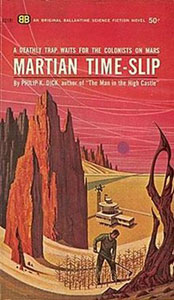“Martian Time-Slip” (1964) is set on the frontier of Mars, so naturally – this being a Philip K. Dick novel – it’s about … the nature of schizophrenia. Granted, the setting isn’t totally random, but it’s interesting that PKD goes to Mars and a 1994 future where Earth has become overpopulated in order to tell a timeless story about the subjective natures of time and perspective. Sometimes you have to go crazy before you can be sane, repairman Jack Bohlen learns, and the wild sci-fi ideas are in service of his search for simplicity and sanity.
A certain point of view
When we think of people with schizophrenia or autism (Dick uses the terms interchangeably, which might not fit with the modern parlance) or anyone who sees the world differently from “normal” people, we assume we can’t ever understand their point of view, even if we might be vaguely sympathetic. The genius of “Martian Time-Slip” is that PKD gives us a window into their world.
In a string of chapters toward the end, we observe a dinner gathering at power broker Arnie Kott’s house from the perspective of all the attendants. Jack experiences it before he’s even there, thanks to his schizophrenia kicking in, and believe it or not, that’s less weird than the point of view of autistic boy Manfred Steiner. He sees the world around him decaying into “gubble,” a close cousin of the “kipple” from “Do Androids Dream of Electric Sheep?” (1968).

(Mental health issues are as common in “Martian Time-Slip” as in modern times, but the prescription is different. Rather than prescribing pills for anxiety, psychiatrist Dr. Glaub will serve as the patient’s authorized representative at the upcoming social event that’s making him anxious.)
Manfred’s observations force us to re-examine what we accept as normal by seeing it through the eyes of someone who does not automatically accept regular events as normal; for example, Jack and Doreen putting the moves on each other on the couch.
PKD follows that expertly crafted sequence with a gripping closing sequence that again plays with time slippage. Via a drug and a ceremony, Arnie gets a dose of the schizophrenic experience, sort of circling back to the events from beginning of the book.
The unnatural nature of time travel
Time travel is rarely straightforward, but “Martian Time-Slip” particularly sells the unnatural quality of the phenomenon. Arnie intends to use his time trip to stake a claim to land near the FDR Mountains that he now knows will be valuable in the future. But he can’t do it because logistical quirks get in the way, and he’s so exhausted by the ordeal he can’t go on — as if he was destined to not be able to buy the land.
PKD characters are often in their own internal worlds, but what’s neat about “Martian Time-Slip” is how they pay a price for their lack of not only sympathy for their fellow man, but even awareness of their fellow man.

Particularly humorous is the case of Arnie. He loses his black-market food supplier, Norbert Steiner, when Norbert commits suicide. (It’s not unusual for PKD’s protagonists to contemplate suicide in a sentence such as, “Suddenly it came to him that he should kill himself.” But it’s unusual for that person to actually be dead one page later.)
Steiner’s assistant, Otto, takes up the business, but he hasn’t gotten around to contacting Arnie yet. In the meantime, Arnie goes into the black market for himself. He sees that Otto is honing in on his territory, and decides he’s his enemy.
It’s not rare to find a story structure where no one knows everyone else yet everyone affects everyone else; PKD used it in “The Man in the High Castle” a couple years prior. But when it’s done this sharply, it’s impressive to behold.
Circular logic
And the circular logic (although we don’t know exactly how it will circle back till the end) of “Martian Time-Slip” is fairly tight. But I have one point of confusion: Arnie and other real-estate speculators aim to purchase land near the FDR Mountains because they’ve heard a rumor that the United Nations plans to develop it into a co-op (an apartment complex with an on-site grocery store) that will attract settlers from Earth.
So presumably the speculators aim to sell the land to the UN. My question is: Who are the speculators buying the land from? I would assume they are buying it from the UN. While this broadly fits with the “circular logic” element of the novel, it doesn’t click into place as well as the rest.
Some readers might take issue with the lack of explanation of how people live on Mars. If we want to, we can assume terraforming and solar panels, but PKD doesn’t bother. It’s a classic example of an author deciding that some details matter and some don’t. We know people can live on Mars because they’re living on Mars, and that’s enough.
One thing that is evocatively laid out is the way the Red Planet has become like the Old West, with settlements separated by wastelands. (Combined with the rarity and value of water here, I got a vibe of “Star Wars’ ” Tatooine, another classic Old West sci-fi planet.) It’s not a place a “normal” person would want to live, but what about someone who is not normal? Mars could be a place of salvation.
The final scene of “Martian Time-Slip” is bizarre, as PKD doesn’t give readers the happy ending he has earned for the book’s most sympathetic figure. Then again, maybe it is a happy ending from that person’s point of view. My head is still spinning, but it’s not from confusion. It’s from getting a peek into a strange world that’s almost never portrayed … and almost understanding it.

